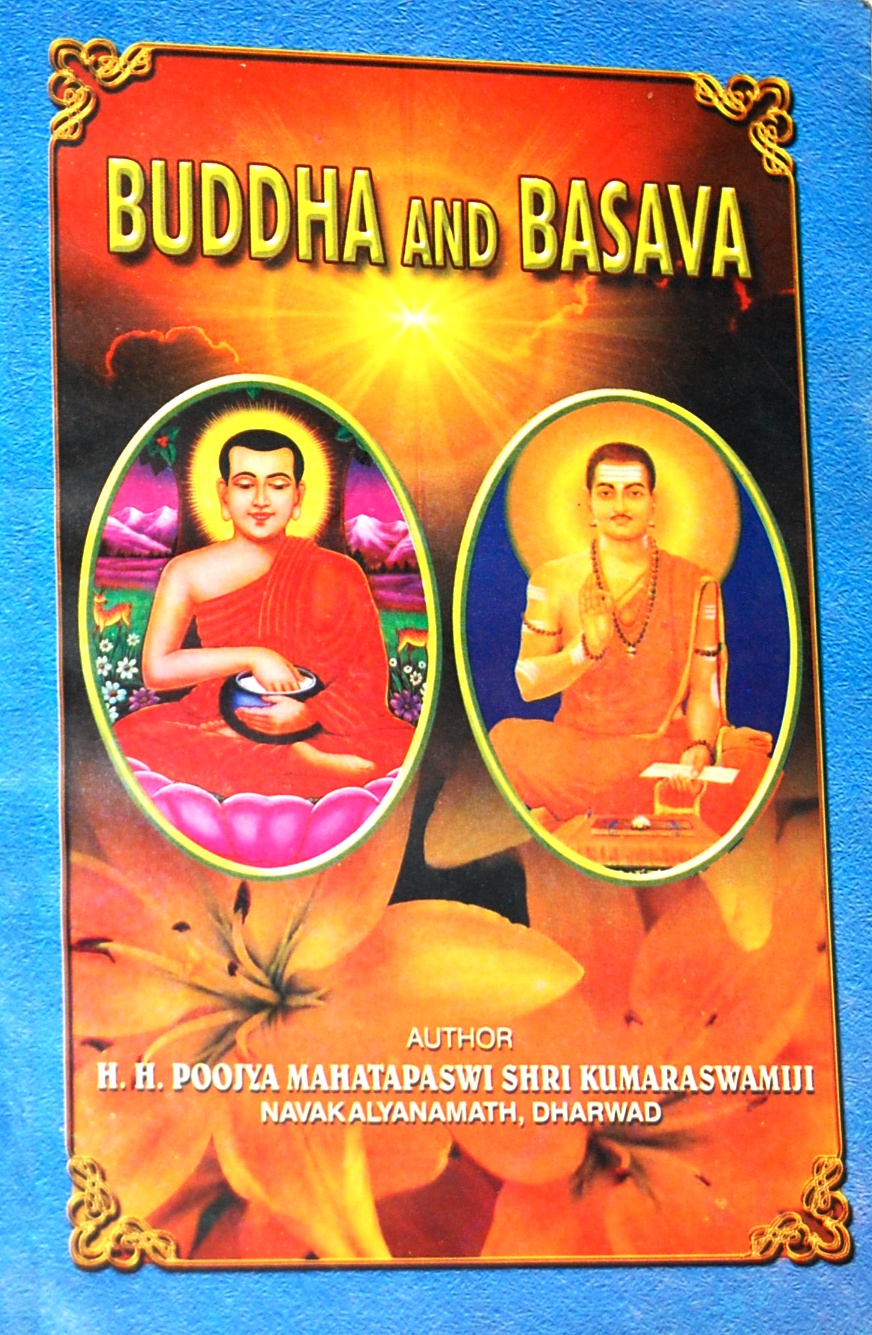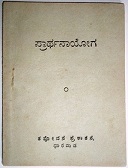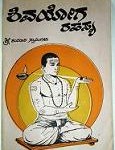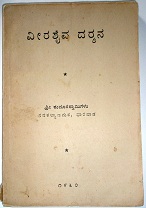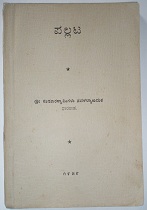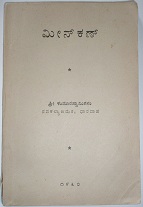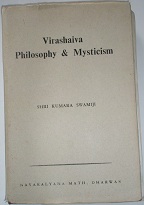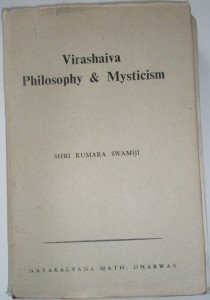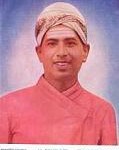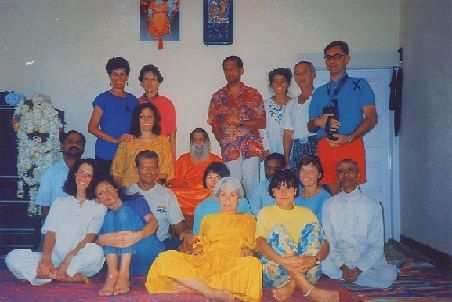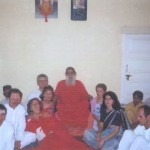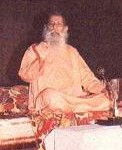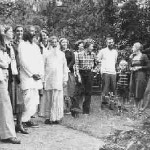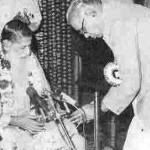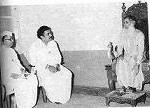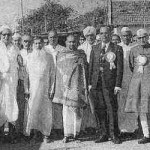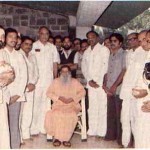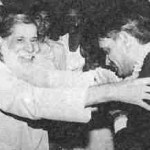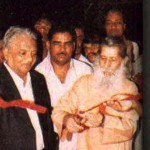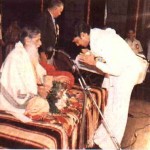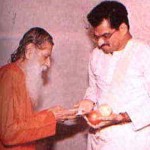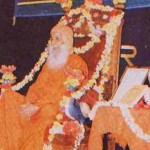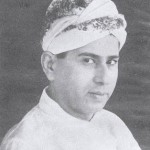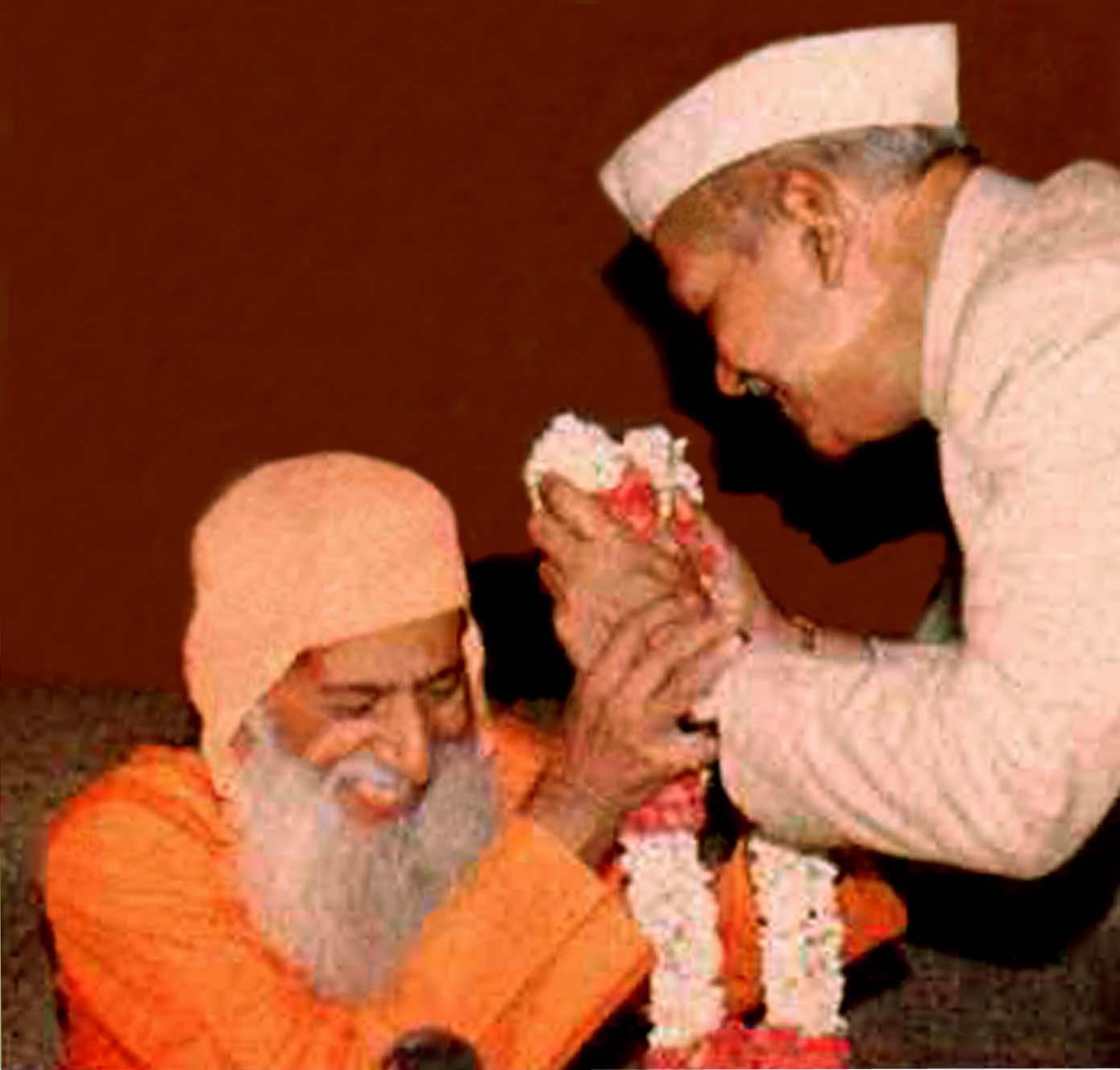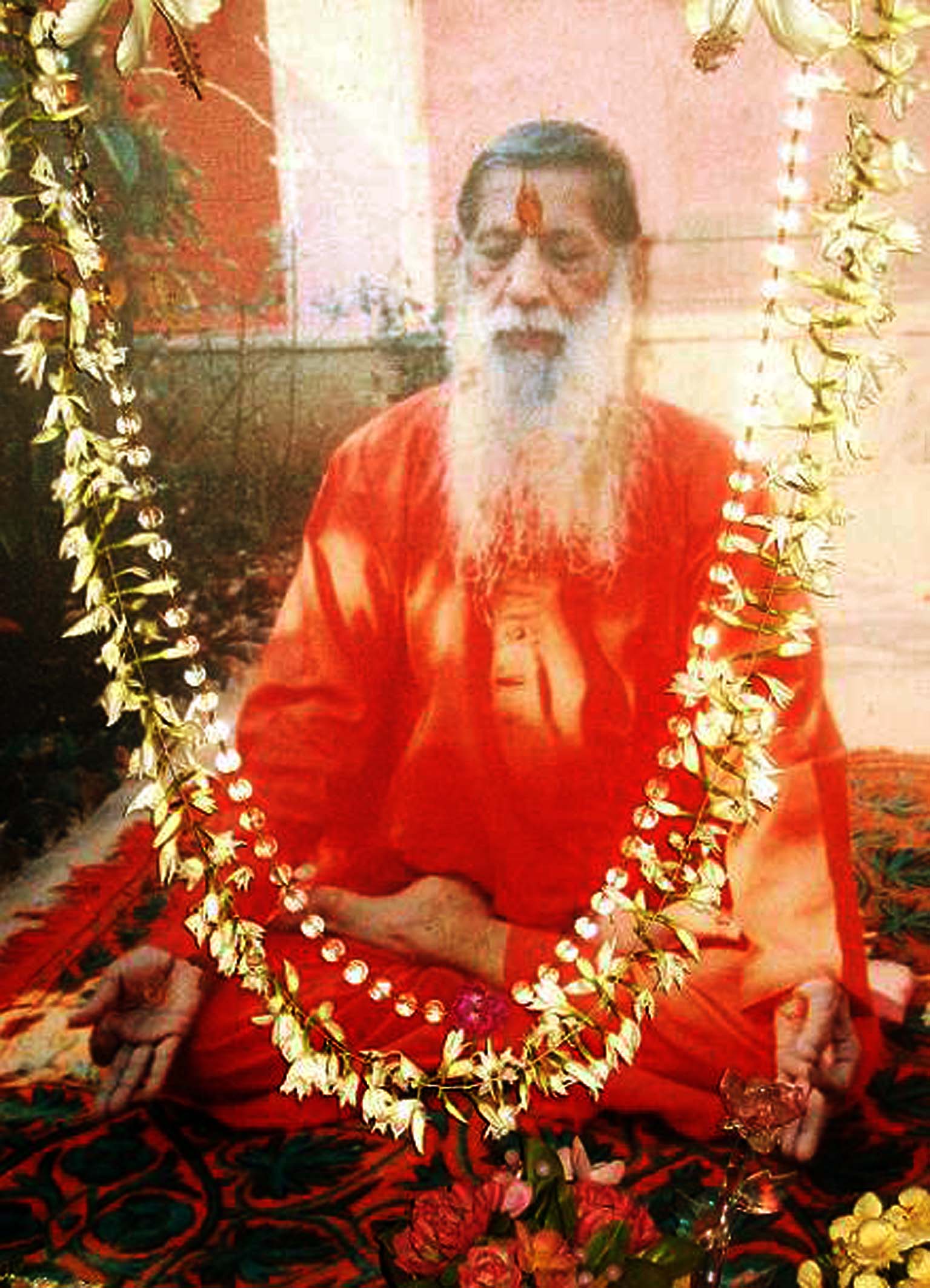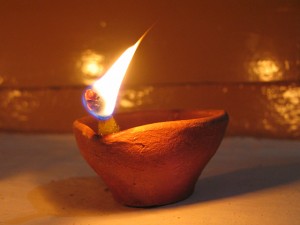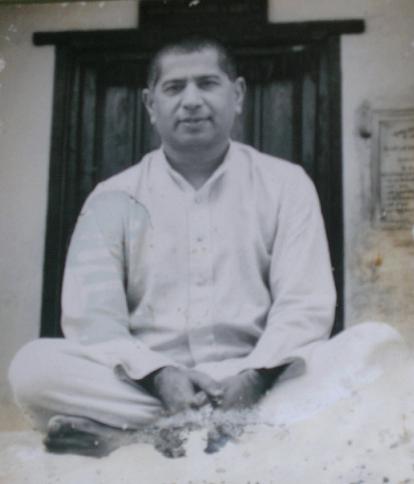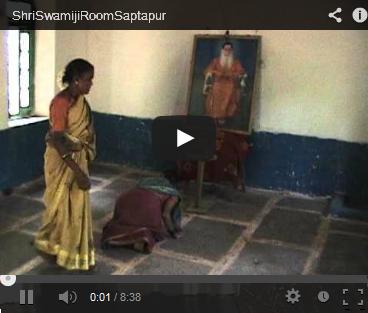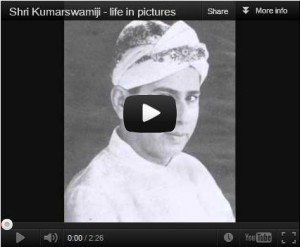The meeting of man and God always means a penetration and entry of the divine into the human and a self-immersion of man in the Divinity. But this immersion is not in the nature of an annihilation. Possession in Oneness and not loss in Oneness is the end and aim of transcendent Life, the ground and goal of evolution. As passion is the key-note of human life, so peace is the key-note of Divine or Transcendent Life. Rising into it man is lifted above inharmony and disturbances. The Transcendent Life is ruled not by passions but by principles. It is founded not upon fleeting impulses but upon abiding laws. In its clear atmosphere the orderly sequence of all things is revealed so that there is seen to be serenity or silence pervading all the contents of the Cosmos. In that serene sphere the transcendent Man or Aikya lives, moves and has his being. Thus we see passion illumined converting into Power and power glorified passing into Peace. This is the promise offered by Sat-sthala.
The cause of evil is one of the great problems of life. The statesman and the priest, the teacher and the parent are engaged in finding out and removing the cause of evil. Different evils are known to have different causes. But it is the ultimate cause of evil that philosophy tries to discover so as to get at the power that an counter-act it. One philosophy attributes evil to desire, another to selfishness, a third one to ignorance, a fourth one to Satan and so on. Some desires are good and others are bad but desires are not ultimate causes. The ultimate desire is the desire to avoid pain. But pain is a relative term; one man’s pain is another man’s pleasure. There are some who find pleasure in sacrificing themselves for the good of others, of their community or country. Pain being thus indefinite, the desire to avoid pain is also indefinite. To say that the ultimate cause of pain is an indefinite thing is to admit ignorance. But ignorance is merely absence of knowledge and is not a thing that has positive existence. A child is said to have put its hand into fire because it did not know that it would burn. The fact is that the child thought that the fire was a beautiful thing and wanted to take it. The real cause is its desire to reach beautiful things. Wrong knowledge may be a cause and not ignorance.
Shaiva as well as Virashaiva philosophy cuts the Gardian knot by denying the very existence of evil. Though Shaivism denies the existence of evil, society not only affirms its existence but works for its eradication. This difference between religious philosophy and social philosophy is due to the fact that the reality with which religion is concerned is the soul, whereas that of society is the body and the worldly possessions. What society calls evil is not non-existent but is the error or wrong of philosophy, and this error or wrong is traced to the insufficiency either of knowing, willing or doing, which are the three activities of the soul. The soul then would function correctly if it received sufficient energy. The supply of energy comes from Maya or the operative power which freely offers all that the soul wants. The allowance is sufficient but the whole of it does not reach the soul. There must be a factor involved in the process which blocks the passage and prevents the flow of energy that is offered. This same thing requires a name and that the Shaiva philosophy calls it Anava which means an atom. To convert this anutva into vibhutva, atomicity into all pervasiveness is the secret of Sat-sthala.
In Virashaivism Sat-sthala represents the path of the pilgrim. The Virashaiva or Lingayat teachers address the Divine as Sthala. The Divine is really unlimited but the inherent Energy in the Divine is responsible for the limitation in the unlimited. Hence the Supreme or Shiva bifercates himself into Linga and Anga; and the divine energy into Shakti and Bhakti. We must mark the meaning of Bhakti. Bhakti generally means the feeling of devotion or attachement to a godhead. But here Bhakti means Upasana or worship which represents a spirit of self-surrender. This is not to say that worship can be performed without devotional feelings, for these feelings are at the bottom of worship. Linga is Upasya, the worshipped, Anga is Upasaka, the worshipper, and Bhakti is Upasana, the worship. Sat-sthala is hierarchy where Upasana grows gaining step by step in content till the apparent duality between Anga and Linga is vanished and Samarasya or at-one-ment is achieved.
Shata-sthala – Six Stages of Evolutionary Consciousness
The one Sthala becomes divided into Anga and Linga which again undergo a three-fold modification each. Thus we have three forms of Anga namely Tyaganga, Bhoganga and Yoganga, correspondingly to three forms of Linga termed Ishta, Prana and Bhava. The soul in the waking condition is known as Vishva Jiva, that in the dreaming condition is Taijasa Jiva and that in the condition of deep sleep is Prajna Jiva. Tyaganga means the transformed Vishva Jiva. He gives up attachment to worldly objects and so is called Tyaganga, because Tyaga or detachment becomes the means through which he realises his Divine nature. Ishta Linga becomes the object of worship to a Tyagangi. Bhoganga means the transformed Taijasa Jiva. The subtle body is the means through which Taijas Jiva experiences pleasure and pain by means of sensual objects. The Devotee, on the other hand, having given up carnal objects and taken to the realisation of the self takes delight only in what is conducive to the spiritual growth. Hence he is called the Bhogangi to whom Prana Linga becomes the object of worship. Yoganaga means transformed Prajna Jiva. He being entangled in the causal body, the matrix of ignorance and Vasanas, remains separate from Shiva. But the mind and the senses of the Bhakta having changed their natural course, he realises in every thing the Divine peace and presence. So the old causal body is destroyed and instead thereof a new state of consciousness is formed. Hence it is called Yoganaga, as it leads to union of Anga with Linga. Bhava Linga becomes the object of worship of the Yogangi. Ishtalinga, Pranlinga and Bhavalinga are therefore a triple aspect of the Divine. Ishtalinga is the individual Divine, extending itself in the realm of eventualities. It fulfils what is contained in the Truth, what works out in the possibilites reflected by the mind, what appears to us as the fact objectively realised. Pranalinga is the universal Divine which takes its stand in the possibilities. It has behind it the freedom of the infinite bringing it into us as a background for the determination of the finite. Every action therefore in the world seems to emerge from a balancing and clashing of various possibilities. Bhavalinga is the infinite Divine which sees the Truth in itself, the truth in its becoming, in its essence. It contains all that is in the idea comprehensively and not pieace-meal.
Then the three-fold modifications further become two-fold each. Thus Ishtalinga becomes Achara-linga, the practical and Guru-linga, the preceptive. Prana-linga becomes Shiva-linga, auspicious, and Chara-linga, the dynamic. Bhavalinga becomes Prasada-linga, the gracious and Maha-linga, the great. Likewise, Tyaganga becomes Bhakta who is characterised by a state of faith, Shraddha-Bhakti in Achara-linga; this is the Bhakta-sthala; and Mahesh is characterised by firm faith, Nishtha-Bhakti in Guru-linga; this is Mahesh Sthala. Bhoganga becomes Prasadi who is characterised by a state of undivided attention, Avadhana-Bhakti to the Shiva-linga; this is Prasadi-Sthala and Pranalingi is characterised by a state of experience, Anubhava-Bhakti of Chara-linga; this is Pranalinga-Sthala. Yoganaga becomes Sharana who is characterised by a mode of pure delight, Ananda-Bhakti derived from the contemplation of Prasada-linga; this is Sharana-sthala and Aikya is characterised by a state of identity, Samarasa-Bhakti with Maha-linga, the Great; this is Aikya Sthala. This is in a nut-shell the crux of Sat-sthala.
Shata-sthala – Six Stages of Evolutionary Consciousness
For the Virashaiva mystic Prema or Love has a wider connotation. It is not merely love that expresses itself in social relationship. But it is pure love which expresses itself in the God. True religion means to have faith not so much in God as in the Good; for Good is Shivam, Satyam. He is a Virashaiva who has a firm faith in the Good, that wins laurels and makes life a sunshine of the Self. To have devout faith in the Good, to have definite aspiration for its workings is to go a long way in transforming lust into love and envy into sympathy. Intense faith and intensive aspiration are represented by Bhakta-sthala and Mahesh-sthala respectively in Virashaivism. Sthala apart from its philosophical meanings signifies a stage, step or halthing place for the soul on its spiritual journey and each stage is a preparation for a further ascent. Virashaivism has devised six steps which the soul must climb to achieve realisation. Of such six steps the first two Bhakta and Mahesha are intended to bring about a transformation of the passional forces into moral powers.
In the first stage, the formidable obstacle that obsesses the Sadhaka, the Bhakta, is blood-relationship according to Virashaiva mystic. It is the attachment to his blood relatives that serves as a serious handicap to his Godward tendency. So he is admonished to seek and fasten the bonds of God-relationship, that is, Bhakta-bandhavya. He is to live as far as possible, without neglecting his daily occupation, in the company of the seekers after God in as much as their company helps the Sadhaka to open himself more on the Godside than on the world-side. That is to say by the help of Satsanga he curbs his downward tendency and claims to manifest his Godward tendency.
In the second stage the Sadhaka meets with the formidable obstacle of self-indulgence. In the initial stage self-indulgence, though present, is subtle and works underneath. But it is in the second stage that it forces its way to surface consciousness from the sub-conscient. For self-indulgence, that is, the idea to indulge in sex is infantile and regressive. It is this sexual impulse which is infantile as well as immoral in nature that hoodwinks the Sadhaka on his way to spiritual realisation. He is therefore enjoined to observe celibacy or strict continence in this second stage. It is for this reason that the Sadhaka in the second stage or Mahesha is termed Virakta. If he is Bhakta in the first stage he is Virakta in the second.
The first two stages then are intended to achieve the purity of blood and conservation of generative fluid. The fundamental physical unit is the Retas in which heat, light and electricity in a man are involved and hidden. All energy is latent in the Retas and this energy may be either expended physically or conserved. All passion from lust to envy waste the energy by dissipating it either in the gross form or in the subtle form, out of the body. Hence immorality in thought, word and deed is not conducive to spiritual development. On the other hand, chastity of body and mind is recommended because all self-control conserves the energy in the Retas and conservation always brings with it an increase. Since the needs of physical body are limited the excess of energy must create a surplus which has to turn itself to some use other than the physical. In the second stage the Sadhaka or Mahesh is enjoined to conserve Retas as a result of which an excess is formed. This excess of Retas turns into heat or Tapas which stimulates the whole system. It is for this reason that all forms of self-control and asceticism are called Tapasya, for they generate the heat or stimulus which is a source of powerful action.
The generation of this psychic heat or Tapas is the marked feature of the third stage or Prasadi-sthala. In this stage the Sadhaka who is named Prasadi never suffers from inaction; for he is a hero of disinterested action. Still the Sadhaka has to be on his guard lest the temptation creeps into distort his disinterested action either by a false show or by foul fame. For temptation is, in this stage, in a recurring state as it was persistent and resistant in the previous two stages. Evil follows temptation as the shadow follows the body. Evil and temptation are the invariable concomitants. So long as man is a victim to temptation in any form, gross, subtle or causal, he is bound to sin and suffer. Man inflicts suffering upon himself through the active instrumentality of his own unpurified or unregenerate nature. He rises into perfect peace in the measure that he purifies his heart. The mental energy which he wastes in the persuance of dark passion is all sufficient to enable him to attain knowledge and wisdon when it is turned in the right direction. As water, when transformed into stream, becomes a new, more definite and wide reaching power, so passion when transmuted into intellectual and moral force becomes a new life, a new vision.
It is this new life guided by a new vision that becomes the key-note of the fourth stage or Pranalinga-sthala. Here Tapas is converted into Tejas, light which is at the source of all knowledge. The Sadhaka or the Prana-Lingi, as he is called, becomes conscious of the inner light, psychic light, transparent light by virtue of which he triumphs over temptaion, overcomes evil and gets the passion transmuted into power. With the process of transmutation, with the disappearance of evil and the emergence of good, there dawns upon him a new vision, a new consciousness. And when this is reached, the Sadhaka has become a sage. He has passed from the human life to the divine life; he is ‘born again’, Dvija and there begins for him a new round of experience, he wields a new power; a new Universe opens out before his spiritual gaze. His prayer ‘Kindly lead me Light’ becomes a fact, for he is guided by the inner Light in his activities. he has brought his entire nature into conformity and harmony with Law of righteousnes. He has made his thoughts pure, his deeds blameless; he has entered into Light and Liberty transcending dark-ness and licence, by perceiving the good in all the manifold aspects of life. With a new vision born of a new consciousness the Prana-lingi sees ‘Books in running brook, sermons in stone and good in every thing.’ For this state is at first a higher order of morality, then a new form of perception and at last a comprehensive understanding of the universal moral causation.
The sage is ushered into the divine Life; and when he practises divine Good he feels life to be all bliss. This does not mean that he does never meet with pain and suffering, but it means that he has the power to change painful sensations to blissful ones by electrical phenomenon. Those outer assaults, harassments and persecutions, which bring such suffering to others, only serve to heighten his happiness; for they cause the deep fountain of Good within him to well up in greater abundance. This power to change painful sensations to blissful ones which is called Vidyut is the feature of the fitfth stage or the Sharana-sthala. Here Tejas is converted into Vidyut, light into electricity; that is to say, inner light is turned into effective Will. With the elecro-magnetic touch the Sharana makes matter dissolve its stiffness and exhibit its pliability so that it can become a safe instrument of spiritual expression. For him matter ceases to exist; he see only the play of spirit through different grades of expressi. To him the Good or Shiva is not merely an abstract principle, but also a concrete person, the centre of all reality, whose very nature is unbounded joy that reveals itself in forms, and whose very will creates the world.
We have seen that effective Will is the emblem of Sharana-sthala. But will has its supreme response not in the World of law, but in the world of freedom; not in the World of Nature but in the World of spirit. Hence the Will which is full, must seek for the realisation of its harmony other wills which are also full and in this is the significance of spiritual life. The infinite centre of Personality which radiates its joy by giving itself out in freedom, must create other centres of freedom to unite with it in harmony. It is this necessity of harmonizing one’s will with the Will of God through freedom of love or Samarasya, as it is termed in Virashaivism, that is the key-note of the sixth stage or Aikya-sthala.
The meeting of man and God always means a penetration and entry of the divine into the human and a self-immersion of man in the Divinity. But this immersion is not in the nature of an annihilation. Possession in Oneness and not loss in Oneness is the end and aim of transcendent Life, the ground and goal of evolution. As passion is the key-note of human life, so peace is the key-note of Divine or Transcendent Life. Rising into it man is lifted above inharmony and disturbances. The Transcendent Life is ruled not by passions but by principles. It is founded not upon fleeting impulses but upon abiding laws. In its clear atmosphere the orderly sequence of all things is revealed so that there is seen to be serenity or silence pervading all the contents of the Cosmos. In that serene sphere the transcendent Man or Aikya lives, moves and has his being. Thus we see passion illumined converting into Power and power glorified passing into Peace.
This is the promise offered by Sat-sthala.
Shata-sthala – Six Stages of Evolutionary Consciousness
For the Virashaiva mystic Prema or Love has a wider connotation. It is not merely love that expresses itself in social relationship. But it is pure love which expresses itself in the God. True religion means to have faith not so much in God as in the Good; for Good is Shivam, Satyam. He is a Virashaiva who has a firm faith in the Good, that wins laurels and makes life a sunshine of the Self. To have devout faith in the Good, to have definite aspiration for its workings is to go a long way in transforming lust into love and envy into sympathy. Intense faith and intensive aspiration are represented by Bhakta-sthala and Mahesh-sthala respectively in Virashaivism. Sthala apart from its philosophical meanings signifies a stage, step or halthing place for the soul on its spiritual journey and each stage is a preparation for a further ascent. Virashaivism has devised six steps which the soul must climb to achieve realisation. Of such six steps the first two Bhakta and Mahesha are intended to bring about a transformation of the passional forces into moral powers.
In the first stage, the formidable obstacle that obsesses the Sadhaka, the Bhakta, is blood-relationship according to Virashaiva mystic. It is the attachment to his blood relatives that serves as a serious handicap to his Godward tendency. So he is admonished to seek and fasten the bonds of God-relationship, that is, Bhakta-bandhavya. He is to live as far as possible, without neglecting his daily occupation, in the company of the seekers after God in as much as their company helps the Sadhaka to open himself more on the Godside than on the world-side. That is to say by the help of Satsanga he curbs his downward tendency and claims to manifest his Godward tendency.
In the second stage the Sadhaka meets with the formidable obstacle of self-indulgence. In the initial stage self-indulgence, though present, is subtle and works underneath. But it is in the second stage that it forces its way to surface consciousness from the sub-conscient. For self-indulgence, that is, the idea to indulge in sex is infantile and regressive. It is this sexual impulse which is infantile as well as immoral in nature that hoodwinks the Sadhaka on his way to spiritual realisation. He is therefore enjoined to observe celibacy or strict continence in this second stage. It is for this reason that the Sadhaka in the second stage or Mahesha is termed Virakta. If he is Bhakta in the first stage he is Virakta in the second.
The first two stages then are intended to achieve the purity of blood and conservation of generative fluid. The fundamental physical unit is the Retas in which heat, light and electricity in a man are involved and hidden. All energy is latent in the Retas and this energy may be either expended physically or conserved. All passion from lust to envy waste the energy by dissipating it either in the gross form or in the subtle form, out of the body. Hence immorality in thought, word and deed is not conducive to spiritual development. On the other hand, chastity of body and mind is recommended because all self-control conserves the energy in the Retas and conservation always brings with it an increase. Since the needs of physical body are limited the excess of energy must create a surplus which has to turn itself to some use other than the physical. In the second stage the Sadhaka or Mahesh is enjoined to conserve Retas as a result of which an excess is formed. This excess of Retas turns into heat or Tapas which stimulates the whole system. It is for this reason that all forms of self-control and asceticism are called Tapasya, for they generate the heat or stimulus which is a source of powerful action.
The generation of this psychic heat or Tapas is the marked feature of the third stage or Prasadi-sthala. In this stage the Sadhaka who is named Prasadi never suffers from inaction; for he is a hero of disinterested action. Still the Sadhaka has to be on his guard lest the temptation creeps into distort his disinterested action either by a false show or by foul fame. For temptation is, in this stage, in a recurring state as it was persistent and resistant in the previous two stages. Evil follows temptation as the shadow follows the body. Evil and temptation are the invariable concomitants. So long as man is a victim to temptation in any form, gross, subtle or causal, he is bound to sin and suffer. Man inflicts suffering upon himself through the active instrumentality of his own unpurified or unregenerate nature. He rises into perfect peace in the measure that he purifies his heart. The mental energy which he wastes in the persuance of dark passion is all sufficient to enable him to attain knowledge and wisdon when it is turned in the right direction. As water, when transformed into stream, becomes a new, more definite and wide reaching power, so passion when transmuted into intellectual and moral force becomes a new life, a new vision.
It is this new life guided by a new vision that becomes the key-note of the fourth stage or Pranalinga-sthala. Here Tapas is converted into Tejas, light which is at the source of all knowledge. The Sadhaka or the Prana-Lingi, as he is called, becomes conscious of the inner light, psychic light, transparent light by virtue of which he triumphs over temptaion, overcomes evil and gets the passion transmuted into power. With the process of transmutation, with the disappearance of evil and the emergence of good, there dawns upon him a new vision, a new consciousness. And when this is reached, the Sadhaka has become a sage. He has passed from the human life to the divine life; he is ‘born again’, Dvija and there begins for him a new round of experience, he wields a new power; a new Universe opens out before his spiritual gaze. His prayer ‘Kindly lead me Light’ becomes a fact, for he is guided by the inner Light in his activities. he has brought his entire nature into conformity and harmony with Law of righteousnes. He has made his thoughts pure, his deeds blameless; he has entered into Light and Liberty transcending dark-ness and licence, by perceiving the good in all the manifold aspects of life. With a new vision born of a new consciousness the Prana-lingi sees ‘Books in running brook, sermons in stone and good in every thing.’ For this state is at first a higher order of morality, then a new form of perception and at last a comprehensive understanding of the universal moral causation.
The sage is ushered into the divine Life; and when he practises divine Good he feels life to be all bliss. This does not mean that he does never meet with pain and suffering, but it means that he has the power to change painful sensations to blissful ones by electrical phenomenon. Those outer assaults, harassments and persecutions, which bring such suffering to others, only serve to heighten his happiness; for they cause the deep fountain of Good within him to well up in greater abundance. This power to change painful sensations to blissful ones which is called Vidyut is the feature of the fitfth stage or the Sharana-sthala. Here Tejas is converted into Vidyut, light into electricity; that is to say, inner light is turned into effective Will. With the elecro-magnetic touch the Sharana makes matter dissolve its stiffness and exhibit its pliability so that it can become a safe instrument of spiritual expression. For him matter ceases to exist; he see only the play of spirit through different grades of expressi. To him the Good or Shiva is not merely an abstract principle, but also a concrete person, the centre of all reality, whose very nature is unbounded joy that reveals itself in forms, and whose very will creates the world.
We have seen that effective Will is the emblem of Sharana-sthala. But will has its supreme response not in the World of law, but in the world of freedom; not in the World of Nature but in the World of spirit. Hence the Will which is full, must seek for the realisation of its harmony other wills which are also full and in this is the significance of spiritual life. The infinite centre of Personality which radiates its joy by giving itself out in freedom, must create other centres of freedom to unite with it in harmony. It is this necessity of harmonizing one’s will with the Will of God through freedom of love or Samarasya, as it is termed in Virashaivism, that is the key-note of the sixth stage or Aikya-sthala.
The meeting of man and God always means a penetration and entry of the divine into the human and a self-immersion of man in the Divinity. But this immersion is not in the nature of an annihilation. Possession in Oneness and not loss in Oneness is the end and aim of transcendent Life, the ground and goal of evolution. As passion is the key-note of human life, so peace is the key-note of Divine or Transcendent Life. Rising into it man is lifted above inharmony and disturbances. The Transcendent Life is ruled not by passions but by principles. It is founded not upon fleeting impulses but upon abiding laws. In its clear atmosphere the orderly sequence of all things is revealed so that there is seen to be serenity or silence pervading all the contents of the Cosmos. In that serene sphere the transcendent Man or Aikya lives, moves and has his being. Thus we see passion illumined converting into Power and power glorified passing into Peace.
This is the promise offered by Sat-sthala.
This article – Shata-sthala – Theological Aspect – is taken from H.H.Mahatapasvi Shri Kumarswamiji-s book, ‘Mirror of Veerashaivism’.











